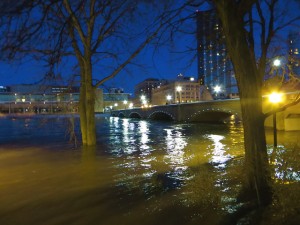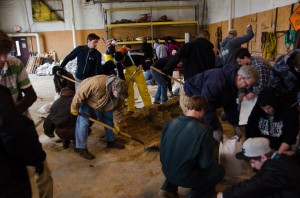WMEAC report sizes up climate resiliency in Grand Rapids

A photo from West Michigan went semi-viral last April because the scene it depicted was so novel: Why was a fish swimming past the window of a Grand Rapids office building?
The fish was exploring new territory opened up by a record-setting flood that battered the city. Days of heavy rain drove the Grand River so high that it nearly breached floodwalls and inundated the downtown area. The flood inflicted $10 million in damage throughout Kent County, drove some 1,700 people from their homes and led Grand Rapids to ask residents to help protect the city with sandbags.
More worrisome than the flood itself are projections that such volatile weather-heavy downpours, extreme heat, freeze-thaw cycles -will become more common in the Great Lakes region as climate change becomes more pronounced. Officials in many cities recognize that infrastructure upgrades and other initiatives will be essential for adapting to new weather patterns.
A report released in December by the West Michigan Environmental Action Council aims to get a conversation going in greater Grand Rapids about how to build a city that can withstand the slings and arrows of a changing climate.
The project arose when the U.S. Conference of Mayors recognized Grand Rapids Mayor George Heartwell for his leadership on climate change issues and granted the city $25,000 for new climate-related projects. Heartwell gave half the money to the Friends of Grand Rapids Parks for tree planting. The rest went to WMEAC-an MEC member group-to prepare a report on the city’s climate resiliency.
You can read the report online here.
We checked in with Nick Occhipinti, WMEAC’s director of policy and community activism, to learn more about the report’s findings and its recommendations for Grand Rapids.
MEC: What, to you, are the take-home points from the report?
Nick: WMEAC worked with Grand Valley State University Professor Elena Lioubimtseva to project temperature and precipitation through the years 2022 and 2042, which roughly coincides with the City of Grand Rapids’ 20-year Master Planning process.
We forecast that average temperature will increase by 4 degrees F and precipitation will increase by 8.5% by 2042. Seasonally, the largest increases in temperature are projected to occur during the winter and the least in summer. The largest percent increase in precipitation is predicted to occur in the winter and spring months. Summer is the only season projected to become drier.
Background research indicates that the Great Lakes region can expect more variable and volatile weather. This trend could lead to more extreme weather events such as storms producing greater than one inch of rain in 24 hours, increased frequency of consecutive days above 90 degrees and 90% humidity, and more freeze-thaw cycles within winter and spring.
MEC: Can you tell us what’s at stake by giving us an example or two of the impacts Grand Rapids and other cities could feel in the coming decades if they don’t become more resilient?
Nick: Potholes and floods. These are just two examples I cherry-picked because they are quite important to the current civic discourse in Grand Rapids. They do not illustrate the broad range or extent of what’s at stake. Not only do we expect more precipitation in the winter and spring, but we expect it to come down much faster and during more extreme storm events. The great flood of 2013 has inspired a tremendous amount of discourse in Grand Rapids around the height of the Grand River floodwalls and improved, green stormwater infrastructure to try and capture more of the precipitation where it falls.
An increase in winter temperatures is expected to bring with it more freeze-thaw cycles. Transportation engineers contributing to our report told us that precipitation, extreme heat and fluctuating temperatures all will wreak havoc on our roads, bridges and transportation infrastructure.
MEC: The methodology behind this report seems like an interesting mix of climate modeling, economic analysis, interviews with experts and other techniques. Tell us a little about the approach.
Nick: Two major ideas formed the foundation of our thinking that ultimately lead to our hybrid methodology:
One, we had to be better than Google. What I mean by that is anyone with a computer and internet access can find climate impacts for the Great Lakes region, Climate Plans for large Midwestern cities and predicted impacts on an assortment of municipal services. We had to create a report that was better than what anyone could put together with a few days on Google. To do that we had to make the report local and we had to dive deep enough into each issue area to meaningfully contribute to the conversation.
Two, we immediately realized that municipal climate resiliency is about more than just energy, water, heat islands and a handful of other issues many climate plans address. Climate resiliency is about the activities that contribute to climate change and those that mitigate it-the expected climate impacts and the best responses or adaptations to those impacts. So you have this two-by-two analytical grid that must be applied across the human municipal experience. It quickly becomes a tangled mess of interacting issues and feedback loops. We refer to that mess as the Climate Knot.
Climate resiliency does not lend itself to an easily categorized set of issues and responses. Order must be imposed upon it, and therefore, any attempt to holistically analyze the issue will necessarily be subjective. Given that limitation, we chose to impose a triple bottom line frame onto the issue – and did our best to probe the issue from that familiar perspective.
So we knew that a meaningful Climate Resiliency Report for Grand Rapids would cover more than the generic issue areas addressed by most climate reports – it had to be specific to the Grand Rapids experience, and it had to go substantively deeper than what one could find by Googling. To accomplish these objectives the report builds local, professional expertise on top of the best climate science and extensive background research. 25 local expert interviews were conducted from a broad range of community sectors. We layered that information-direct knowledge of how a city delivers municipal services and community organizations and citizens function within that system-on top of a climate model run for Grand Rapids. With all the information gathered and organized, we analyzed the impacts across 22 issue areas.
MEC: What kind of response has the report received locally? Are the city and/or other entities taking note of your recommendations? What do you hope will come of the report ultimately?
Nick: The report has received a tremendous response. Already, the Grand Rapids Press and MLive have run a series of stories referencing the report. The West Michigan Community Sustainability Partnership held a summit on the report on January 9. Grand Rapids Mayor Heartwell has taken the report with him to President Obama’s State, Local, and Tribal Leaders Task Force on Climate Preparedness – of which the mayor is a delegate. The mayor has also highlighted the report in his State of the City address and on his video blog, and we are working with Grand Rapids’ office of Energy and Sustainability to integrate it at the department level.
We are in the process of planning to further share the report – possibly adapting it for local units of government around the region, granularizing the science even further – and are looking for partners to accomplish this. The report is designed as an electronic document for ease of distribution, sharing, and to save paper and money. Most importantly, the electronic version serves as an electronic gateway to a rich collection of source materials, documents, and citations instantly accessible through embedded links.
###
Grand River photo courtesy Rachel Kramer via Flickr.
Other photos courtesy WMEAC.





Comments are closed.